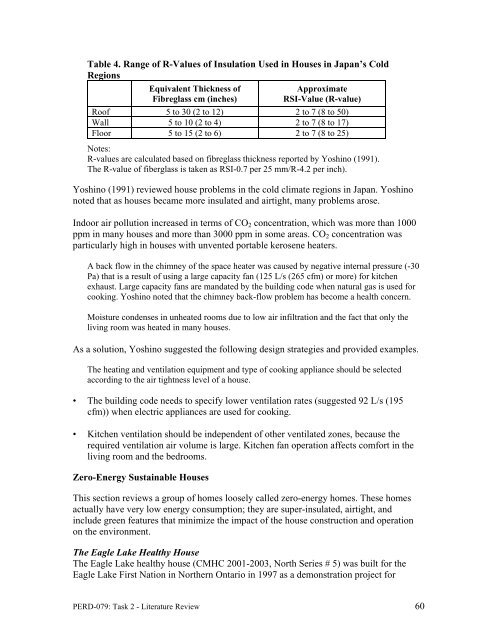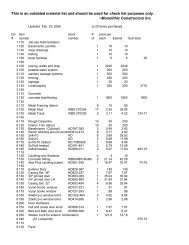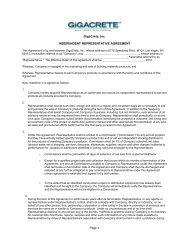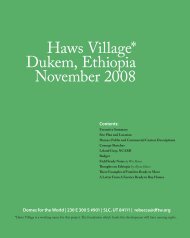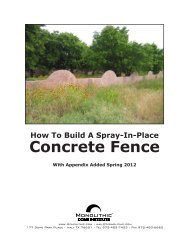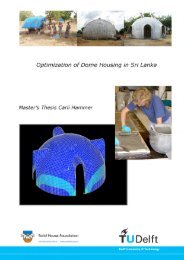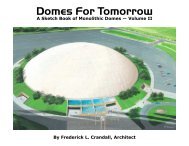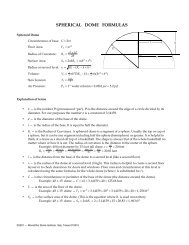Literature Review on Building Envelope, Heating and ... - Beeshive.org
Literature Review on Building Envelope, Heating and ... - Beeshive.org
Literature Review on Building Envelope, Heating and ... - Beeshive.org
You also want an ePaper? Increase the reach of your titles
YUMPU automatically turns print PDFs into web optimized ePapers that Google loves.
Table 4. Range of R-Values of Insulati<strong>on</strong> Used in Houses in Japan’s Cold<br />
Regi<strong>on</strong>s<br />
Equivalent Thickness of<br />
Fibreglass cm (inches)<br />
Approximate<br />
RSI-Value (R-value)<br />
Roof 5 to 30 (2 to 12) 2 to 7 (8 to 50)<br />
Wall 5 to 10 (2 to 4) 2 to 7 (8 to 17)<br />
Floor 5 to 15 (2 to 6) 2 to 7 (8 to 25)<br />
Notes:<br />
R-values are calculated based <strong>on</strong> fibreglass thickness reported by Yoshino (1991).<br />
The R-value of fiberglass is taken as RSI-0.7 per 25 mm/R-4.2 per inch).<br />
Yoshino (1991) reviewed house problems in the cold climate regi<strong>on</strong>s in Japan. Yoshino<br />
noted that as houses became more insulated <strong>and</strong> airtight, many problems arose.<br />
Indoor air polluti<strong>on</strong> increased in terms of CO 2 c<strong>on</strong>centrati<strong>on</strong>, which was more than 1000<br />
ppm in many houses <strong>and</strong> more than 3000 ppm in some areas. CO 2 c<strong>on</strong>centrati<strong>on</strong> was<br />
particularly high in houses with unvented portable kerosene heaters.<br />
A back flow in the chimney of the space heater was caused by negative internal pressure (-30<br />
Pa) that is a result of using a large capacity fan (125 L/s (265 cfm) or more) for kitchen<br />
exhaust. Large capacity fans are m<strong>and</strong>ated by the building code when natural gas is used for<br />
cooking. Yoshino noted that the chimney back-flow problem has become a health c<strong>on</strong>cern.<br />
Moisture c<strong>on</strong>denses in unheated rooms due to low air infiltrati<strong>on</strong> <strong>and</strong> the fact that <strong>on</strong>ly the<br />
living room was heated in many houses.<br />
As a soluti<strong>on</strong>, Yoshino suggested the following design strategies <strong>and</strong> provided examples.<br />
The heating <strong>and</strong> ventilati<strong>on</strong> equipment <strong>and</strong> type of cooking appliance should be selected<br />
according to the air tightness level of a house.<br />
• The building code needs to specify lower ventilati<strong>on</strong> rates (suggested 92 L/s (195<br />
cfm)) when electric appliances are used for cooking.<br />
• Kitchen ventilati<strong>on</strong> should be independent of other ventilated z<strong>on</strong>es, because the<br />
required ventilati<strong>on</strong> air volume is large. Kitchen fan operati<strong>on</strong> affects comfort in the<br />
living room <strong>and</strong> the bedrooms.<br />
Zero-Energy Sustainable Houses<br />
This secti<strong>on</strong> reviews a group of homes loosely called zero-energy homes. These homes<br />
actually have very low energy c<strong>on</strong>sumpti<strong>on</strong>; they are super-insulated, airtight, <strong>and</strong><br />
include green features that minimize the impact of the house c<strong>on</strong>structi<strong>on</strong> <strong>and</strong> operati<strong>on</strong><br />
<strong>on</strong> the envir<strong>on</strong>ment.<br />
The Eagle Lake Healthy House<br />
The Eagle Lake healthy house (CMHC 2001-2003, North Series # 5) was built for the<br />
Eagle Lake First Nati<strong>on</strong> in Northern Ontario in 1997 as a dem<strong>on</strong>strati<strong>on</strong> project for<br />
PERD-079: Task 2 - <str<strong>on</strong>g>Literature</str<strong>on</strong>g> <str<strong>on</strong>g>Review</str<strong>on</strong>g> 60


